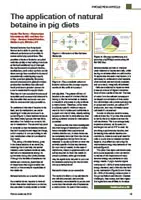Natural betaine has long been known to be able to provide significant performance benefits to commercial pig operations. The positive effects of betaine coupled with the ability of including it in diets at limited additional cost through the replacement of added choline, methionine, and under certain conditions energy has resulted in demand consistently outstripping supply of the product globally. However, recent investment in global betaine production facilities has allowed feed producers greater access to a more sustainable supply chain. This has in-turn resulted in renewed scientific and commercial interest in the benefits this molecule can provide to commercial pig operations.
To understand the role of betaine in the feed, and its metabolism, an understanding of molecular structure is required (Figure 1). Each betaine molecule has three methyl groups that are labile, and allow it to function as a methyl donor in metabolism. The second key point to consider is that the betaine molecule has both a positive and negative charge, which means it is non-perturbing to cellular metabolism when accumulated to high levels.
This, along with other factors, gives it the characteristics of an osmolyte, meaning that it can help the animal maintain water balance inside its cells, and reduce maintenance energy requirements during this whole process. Although the benefits of betaine to the animal are numerous, essentially all of these have their origin in either the methyl, or the osmolytic capabilities of the molecule.
Natural betaine as a methyl donor
As a methyl-donor, betaine is more efficient than either methionine or choline, that are often routinely added to broiler and pig diets. The greater efficacy of betaine is the result of choline chloride having to first be converted to betaine in metabolic processes to play a role as a methyl donor. Therefore, whilst there is a dietary specific minimum requirement for both choline and methionine to support non-methyl roles, directly adding betaine to the diet is more effective than adding synthetic choline for methylation purposes.
Several studies that have investigated the interchange of betaine and choline have concluded that supplemental choline chloride can, in most instances be completely removed from the diet as the endogenous choline from the raw materials is usually sufficient to meet the animal’s specific choline requirements (for non-methyl needs). In the case of methionine, dietary supplementation will still be required to meet the needs for protein synthesis, although the levels may be significantly reduced to account for betaine substituting for methionine’s role as a methyl donor.
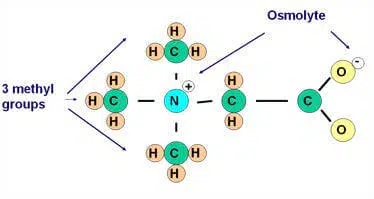 | 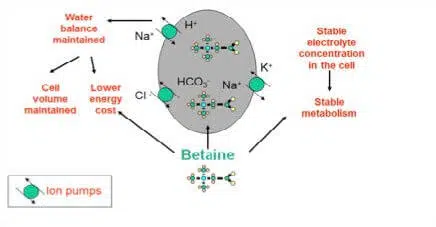 | 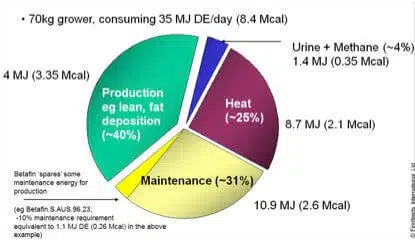 |
Figure 1 : Structure of the Betaine Molecule | Figure 2 : The osmolytic effect of betaine reduces the energy requirements of the cells ion pumpsbetaine | Figure 3 : Energy partitioning in a growing pig (70kgs) consuming 35 MJ DE /day. |
Natural betaine as an osmolyte
The osmolytic effects of natural betaine are well documented, and provide substantially more benefits to poultry and swine than the simple role of betaine as a methyl donor. As part of this function, pumpsbetaine enables animals to maintain water balance in tissues and cells, whilst having no adverse effect on cell function. To appreciate the exact mechanism, it is necessary to understand what happens when animals are osmotically stressed, and as a result, marginally dehydrated.
Cells are subjected to hyper-osmotic stress as a result of higher concentrations of ions outside of the cell. The loss of water from the cell and consequent increased concentration of ions inside the cell interfere with protein and enzyme structure and function, as well as ATP production, and may ultimately cause cell death if uncorrected.
In order to alleviate osmotic stress, cells activate Na / K pumps that attempt to rectify the ionic balance across the cell membrane. This is an energetically expensive process, as for every ion exchange one unit of ATP is used. By providing supplementary betaine, and increasing intra-cellular betaine concentrations, there is a reduced need for cells to pump ions to maintain osmotic balance, thus effectively reducing the maintenance energy requirements of the animal (Figure 2).
This effect has been well demonstrated in swine especially when we remind ourselves of the importance of maintenance energy requirements to daily energy needs. A pig’s visceral organs comprise 40 – 50% of total maintenance energy demand, and within this the Na/K pump mechanism (Figure 2) contributes 30 – 60% of the energy consumption in the gut epithelium and the liver. Disease challenges, heat stress, and less digestible ingredients are all likely to increase the maintenance energy requirement for ion pumps. It has been estimated, for example, that maintenance energy sparing due to dietary betaine was approximately 10% of total maintenance energy, or around 3% of total dietary energy in pigs (Figure 3).
In situations where environmental heat stress is experienced, the beneficial effects of betaine’s osmotic properties become particularly apparent. Betaine can help maintain water balance in all cells but is used as a methyl source in the liver of farm animals and, in some species, in the kidney. So, importantly, it is possible to obtain both methyl and osmotic benefits of betaine from the same inclusion.
Improved lean growth and carcass composition with natural betaine
An improvement in the lean growth of pigs with betaine supplementation has been demonstrated in several trials. This effect is likely to be from a combination of the osmolytic and methylation functions of betaine. The osmolytic functions relate to both the level of hydration affecting the activity of the muscle cells, as well as decreased maintenance energy costs leaving more energy available for growth and lean gain, assuming sufficient availability of amino acids. It needs to be borne in mind that dissected lean muscle is essentially 70 – 75% water, and thus the effect of an osmolyte will tend to increase muscle mass. The methylation capacity of betaine results in uplifted production of creatine and carnitine in the liver as well as a higher RNA to DNA ratio in the muscle, indicative of increased protein synthesis.
The relative magnitude of improvements in lean gain in the pig have been demonstrated to be largely dependent on the energy intake of the animal and the stage of growth. During the protein accretion phase, extra dietary energy supply will fuel increased lean growth provided that amino acid supply is not limiting (Figure 4). The level at which this “plateau” is reached has an interaction with both sex and genotype. Certain genotypes with relatively low appetites and a high propensity for lean growth, can remain on the ascending part of the graph until close to slaughter, especially if fed on a low energy density diet. Also under commercial farming conditions environmental stress will often cause the feed intake of the pig to be lower than its maximum potential, increasing the likelihood of benefits from an uplift in energy availability by the use of betaine.
Data from 5 trials showed benefits in daily gain, FCR, lean gain, and lean gain: feed intake with betaine inclusion in the diet (Figure 5). This data also confirmed the expected higher responses when dietary energy intake was limiting.
Improvements in loin eye area, as well as eye muscle thickness have been shown across several trials. An average back-fat reduction of 12% was also demonstrated across six trials and two commercial data sets. Bunge also noted a 14% reduction in P2 fat thickness, whist simultaneously finding a marked reduction in the variability of this parameter within the pigs when supplemented with dietary betaine.
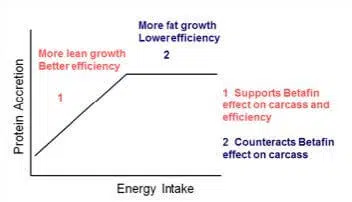 | 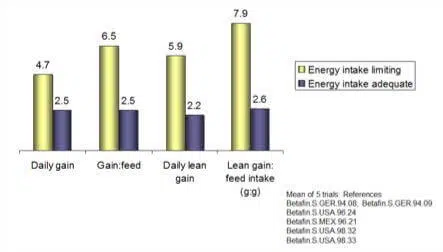 |
Figure 4 : The relationship between energy intake and the effects of betafin supplementation. | Figure 5 : Responses (%) in daily gain, gain : feed, daily lean gain, and lean gain : feed intake with dietary addition of betaine in situations where dietary energy intake was limiting, versus adequate dietary energy intake. |
Heat stress reduction with natural betaine
Work done by Teeter et al (1999) demonstrated that water retention in broilers improved in diets supplemented with betaine, and that the magnitude of this effect appeared to increase with environmental stress, either from heat or a coccidiosis challenge. Cronje (2006) suggested that exposure to heat results in redistribution of blood to the periphery of the body and compensatory reduction in the blood supply to the gut, which damages the cell lining of the gut permitting endotoxin to enter the body. This effect is potentially enhanced in production livestock where energy dense diets are known to cause damage to the gut lining. In summary, the osmolytic benefits of betaine not only ameliorate performance losses in heat stressed animals, but also render them more resilient to episodes of heat stress. This effect is likely to be largely driven by increased water holding capacity of the cells at an intestinal level, reducing the overall maintenance energy requirement of the gut and improving its functionality.
Benefits of natural betaine in the young pig
The young pig faces several challenges after weaning, including:
- dehydration,
- changes in gut structure which can reduce nutrient digestibility and provide more substrate for bacteria,
- the release of toxins in the gut by pathogenic bacteria disturbing water balance, and
- the potential for coccidiosis which can contribute to poor performance. Work done at the University of Leeds demonstrated significant improvements in the gut absorptive area and gut structure with pigs fed a dietary inclusion of betaine to 20 days post weaning. A large amount of research has been done in the poultry industry to show the benefits of dietary betaine when coccidiosis challenges are experienced. Reductions in coccidial related lesions, improvements in gut tensile strength, and improved villus height were identified as the primary factors in this response.
Research across eight trials demonstrated improvements in daily gain, daily feed intake, and FCR in young pigs after weaning. The correlation between higher growth rates post weaning and a reduction in days to slaughter is well recognised, together with the resultant economic benefits.
Benefits of feeding natural Betaine to sows
Three consecutive trials at Bunge Meat Industries with 120 – 160 sows in each trial showed consistent increases of approximately 1.2 piglets born alive where dietary betaine was included in the sow’s lactation diet at a rate of 2kg/ tonne. This translated in to an increased number of pigs weaned per sow. It was also noted that the milk of the sows fed dietary betaine increased markedly in its betaine concentration versus a control diet. It is thus likely that the intake of this betaine enriched milk from the sow will result in several of the benefits previously described in the young pig.
A more recent trial conducted at a research facility in Spain confirmed a significant increase in piglets born alive from the second parity onwards, as well as pigs weaned per sow. The betaine content of the sow’s milk in this trial was also higher versus the control sow treatment. Van Wettere et. al had similar findings, demonstrating a significant increase in litter size for sows in their 3rd, and subsequent parities where betaine was included in the sow gestation diets during summer in Australia. Based on the available literature, it is suggested that betaine supplementation could have increased conceptus survival through any or all of three mechanisms :
- reduced homocysteine concentrations due to altered methionine metabolism,
- increased efficiency of energy utilisation, and/or
- increased growth hormone secretion.
Conclusion
In summary, there is a large body of research supporting the significant role of betaine in pig diets. Improved carcass composition, increased lean growth, reduced maintenance energy requirements, improved tolerance to heat stress, and maintenance of gut health (especially under challenge conditions), are some of the primary benefits that have been shown in trials. Demonstration of these benefits in sows, younger pigs (post-weaning), and growing-finishing pigs suggests a wide application for betaine throughout the pig herd.
The increase in global betaine supply, coupled with the strong body of research data supporting its application in feed, leaves little doubt that betaine will become an important tool to enable nutritionists to maximise swine performance and reduce production costs.
References available on request
Chemuniqué empowers feed and food producers with the most innovative animal performance solutions, enabling our clients to consistently advance the efficiency of production.









